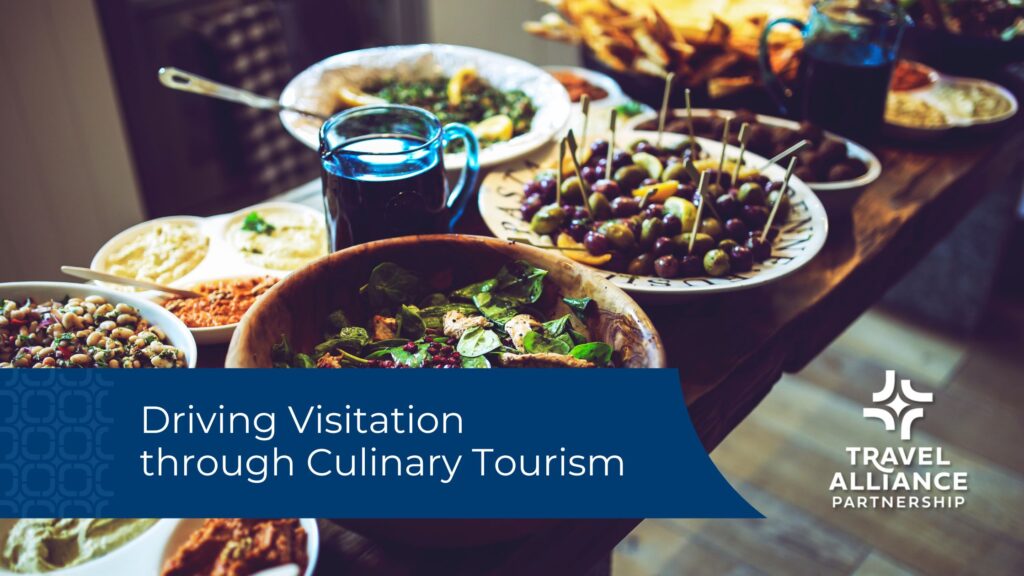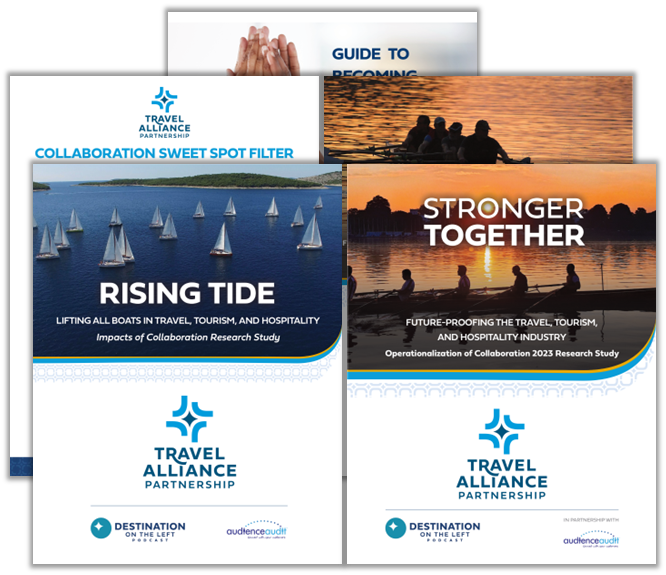Driving Visitation Through Culinary Tourism
When visitors come to a destination, they’re looking for experiences that feel authentic and unforgettable. Few things connect people—or capture the essence of a place—like food. Culinary tourism gives destinations a flavorful way to tell their stories, stand out from the competition, and drive visitation.

Using Culinary Tourism to Tell Your Story
Every destination is looking for ways to stand out, and culinary tourism offers a flavorful way to do it. Food tells the story of a place—its people, culture, and traditions—through experiences that engage all the senses. By spotlighting local flavors and the makers behind them, destinations can create authentic connections that turn a visit into a lasting memory.
Crafting a “Taste of Place”
We spoke with Rebecca Mackenzie, President and CEO of the Culinary Tourism Alliance, about how destinations can craft their own “taste of place.” She shared how food and beverage experiences can bring to life the people and businesses that make each community unique. By highlighting these local producers, destinations can create multi-sensory experiences that leave a lasting impression and inspire visitors to come back for more.
Learn more about the Culinary Tourism Alliance in Episode 325 of Destination on the Left
Bringing Stories to Life Through Food
Karolina Guilcapi of luxury tour company Sated Ventures has carved out a niche in the travel industry by telling the stories of South American destinations through food. Rather than focusing solely on traditional attractions, Guilcapi partners with local chefs and restaurants to create immersive culinary adventures that showcase each region’s unique flavors and dining experiences. Her approach demonstrates that food can tell a powerful story—one that helps travelers connect deeply with a destination’s culture and spirit.
Learn more about Sated Ventures in Episode 251 of Destination on the Left.
Creating a Culinary Tourism Product
Destinations already have local restaurants and food producers, so developing a tourism product centered around food is an effective way to attract visitors while benefiting local businesses.
Maple in the County
Over 20 years ago, Rebecca Mackenzie developed Maple in the County in Prince Edward County, Canada. Maple producers were already putting on maple syrup-related events, and the county wanted to capitalize on this and bring in other local businesses. This led to a program called Maple in the County, an event that encouraged local businesses to develop creative maple-themed products and experiences. Nearly 100 businesses participated, and the event led to more visitors spending more time in the county. Developing one clear brand allowed Prince Edward County to tell its story in a unique way that would attract visitors and showcase local businesses.
Developing Food Tours
On Episode 329 of Destination on the Left, we spoke with Bonnie Hayes, Director of Tourism Development for the City of Thomasville, and Debra Smith, founder of Taste of Thomasville, about turning a food tour into a tourism experience. Taste of Thomasville was born in 2013, after Debra Smith attended a food tour in another city, and realized that was exactly what Thomasville, GA was missing. She attended Food Pros courses to learn how to develop a food tour and has since hosted 1,469 tours for Thomasville visitors.
The Value of Culinary Tourism Products
In our conversation with Bonnie, she talks about the value of creating a culinary tourism product such as Taste of Thomasville. The tour is not simply one size fits all. Smith has developed tours to fit the needs of both the visitors and the Thomasville Visitor’s Center. She offers daytime tours, evening tours for visitors interested in trying local cocktails, and even tours for children and high schoolers.
These food tours have become valuable to Thomasville when they host group visits. Food tours are the perfect way to fill a group’s day, teach them about the destination, and show off a variety of local restaurants.
Getting Creative with Food Tours
Every year Thomasville holds a holiday Victorian Festival that takes place in the evening. The city needed a daytime activity to fill visitors’ time, so they turned to Taste of Thomasville, who in turn developed a Victorian Sweets tour.
The possibilities are endless when you create a versatile culinary tourism product that can be adjusted to any situation and any kind of visitor. Food tours have the power to become a destination of their own, with Taste of Thomasville being one reason many visitors come to Thomasville.
Driving Success with Partnerships in Culinary Tourism
In our podcast conversation, Bonnie Hayes and Debra Smith also talk about the value of partnerships in the tourism industry. Taste of Thomasville would not have experienced the success it has without a positive partnership with the Thomasville Visitor’s Center. As a result of the partnership, the food tours have sold more tickets and Thomasville has gained more visitors.
Partnering with Local Restaurants
Food tours can also create mutually beneficial relationships with the restaurants in your destination. Restaurants will promote the tours, and the tours promote the restaurants. Food tours can help local restaurants acquire new customers and often result in return visitation when tour attendees find a restaurant they love.
Another creative way to partner with local restaurants is through a restaurant week. On Episode 294 of Destination on the Left, Olivia Novak shared how Discover Lancaster partnered with Lancaster City to hold Lancaster County Restaurant Week, an event that would help raise money for the Lancaster Farmland Trust. They partnered with local restaurants that featured menu items made with locally sourced ingredients. This partnership drove visitors to Lancaster, increased visitation to local restaurants, and raised money and awareness for Lancaster Farmland Trust.
Bringing the Flavor to your Visitors
Unforgettable food experiences likely already exist in your destination, waiting to be celebrated. By leaning into those experiences and building partnerships with local restaurants, chefs, and producers, destinations can transform meals into memories and flavors into stories.
Culinary tourism isn’t just about dining—it’s about connection, creativity, and community. When destinations embrace their culinary identity, they give visitors a reason to return again and again, hungry for more.
Author
Related Posts
How Curated Experiences Can Help Your Tourism Marketing
In years past, travelers may have been satisfied to see sites like the Eiffel Tower or Colosseum; now they want to get behind the scenes,...
Marketing for Group Travel: Building Solid Relationships with Tour Operators
Group travel is a significant segment of the tourism market, and if you want to see those buses pulling up to the curb and filling…
